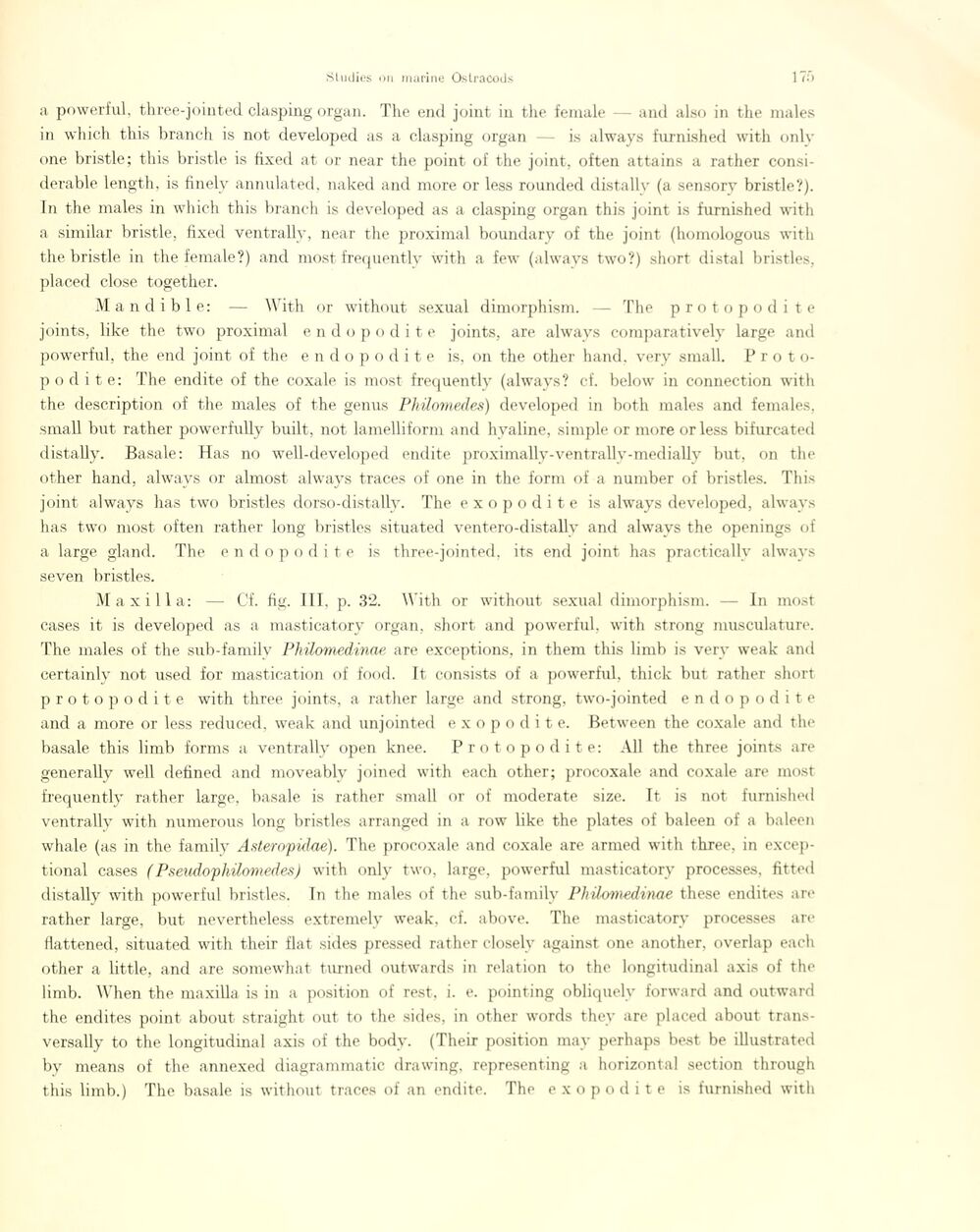
Full resolution (JPEG) - On this page / på denna sida - Sidor ...

<< prev. page << föreg. sida << >> nästa sida >> next page >>
Below is the raw OCR text
from the above scanned image.
Do you see an error? Proofread the page now!
Här nedan syns maskintolkade texten från faksimilbilden ovan.
Ser du något fel? Korrekturläs sidan nu!
This page has never been proofread. / Denna sida har aldrig korrekturlästs.
a powerful, three-jointed clasping organ. The end joint in the female — and also in the males
in which this branch is not developed as a clasping organ — is always furnished with onlv
one bristle; this bristle is fixed at or near the point of the joint, often attains a rather
considérable length, is finely annulated, naked and more or less rounded distally (a sensory bristle?).
In the males in which this branch is developed as a clasping organ this joint is furnished with
a similar bristle, fixed ventrally, near the proximal boundary of the joint (homologous with
the bristle in the female?) and most frequently with a few (always two?) short distal bristles,
placed close together.
Mandible: — With or without sexual dimorphism. — The protopodite
joints, like the two proximal endopodite joints, are always comparatively large and
powerful, the end joint of the e n d o p o d i t e is, on the otlier hånd. very small.
Protopodite: The endite of the coxale is most frequently (always? cf. below in connection with
the description of the males of the genus Philomedes) developed in both males and females,
small but rather powerfully built, not lamelliform and hyaline, simple or more or less bifurcated
distally. Basale: Has no well-developed endite proximally-ventrally-medially but, on the
other hånd, always or almost always traces of one in the form of a number of bristles. This
joint always has two bristles dorso-distally. The exopodite is always developed, always
has two most often rather long bristles situated ventero-distallv and always the openings of
a large giand. The endopodite is three-jointed, its end joint has practically always
seven bristles.
Maxilla: — Cf. fig. III, p. 32. With or without sexual dimorphism. — In most
cases it is developed as a mastieatory organ, short and powerful, with strong musculature.
The males of the sub-familv Phüomedinae are exceptions, in them this limb is verv weak and
certainly not used for mastication of food. It consists of a powerful, thick but rather short
protopodite with three joints, a rather large and strong, two-jointed endopodite
and a more or less reduced, weak and unjointed exopodite. Between the coxale and the
basale this limb forms a ventrally open knee. Protopodite: All the three joints are
generally well defined and moveably joined with each other; procoxale and coxale are most
frequently rather large, basale is rather small or of moderate size. It is not furnished
ventrally with numerous long bristles arranged in a row like the plates of baleen of a baleen
whale (as in the family Asteropidae). The procoxale and coxale are armed with three, in
excep-tional cases ( Pxeudophilomedes) with only two, large, powerful mastieatory processes, fitted
distally with powerful bristles. Tn the males of the sub-family Phüomedinae these endites are
rather large, but nevertheless extremely weak, cf. above. The mastieatory processes are
flattened, situated with their flat sides pressed rather closelv against one another, overlap each
other a little, and are somewhat turned outwards in relation to the longitudinal axis of the
limb. When the maxilla is in a position of rest, i. e. pointing obliquelv forward and outward
the endites point about straight out to the sides, in other words they are placed about
transversally to the longitudinal axis of the body. (Their position mav perhaps best be illustrated
by means of the annexed diagrammatic drawing, representing a horizontal section through
this limb.) The basale is without traces of an endite. The exopodite is furnished with
<< prev. page << föreg. sida << >> nästa sida >> next page >>